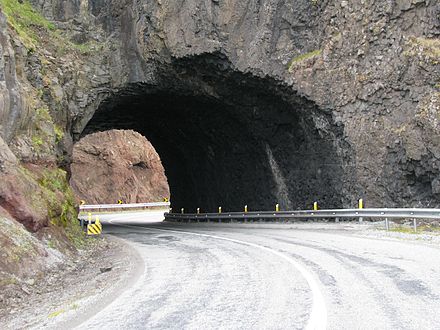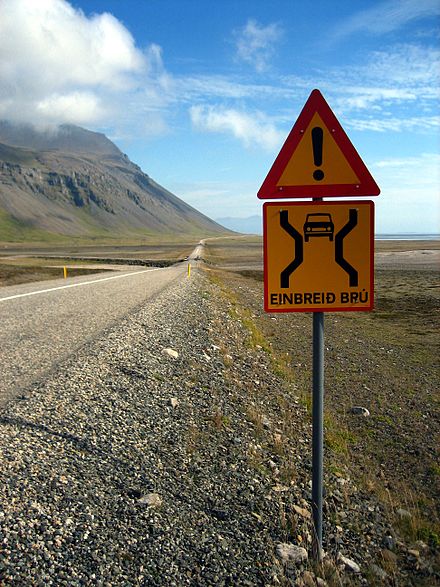Driving in Iceland
Driving in Iceland
With no railroads and sparse population density outside the immediate Reykjavik area, driving is one of the easier ways around Iceland. However, there are some pitfalls and potential problems to avoid, especially in remote parts of the country.
Understand
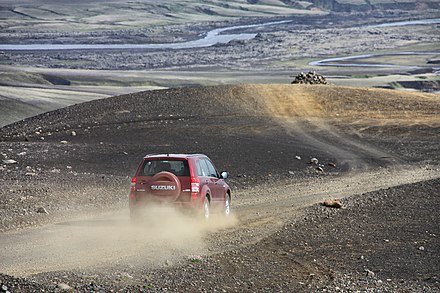
As in most of Europe, Iceland has right-hand driving. Most roads are two-lane undivided; there are multiple lanes in each direction in and around the capital area. General speed limit on paved roads is 90 km/h and speed is often slower due to road conditions. Only main roads in Iceland are paved, while two thirds of the roads are gravel roads. On gravel roads the speed limit is reduced to 80 km/h. Rest areas with a picnic table are found along many roads, but often without toilet facilities. Toilets are mainly found at petrol stations, restaurants and camping grounds, typically at no extra charge but travelers should have coins available if there is a modest fee.
The city center of Reykjavik may be confusing to navigate for the first time visitor due to many one-way streets. Traffic is rarely heavy, mostly during rush hour in the capital area, and during holidays on the roads out of the capital area. Outside of cities, even on main roads, traffic is usually light.
In some parts of Iceland, the next petrol station might be 200 km away, due to the sparse population in the country. So you should fill up the tank in time. In more remote areas, petrol stations may not have a café or attendant - just a pump and payment station where credit or debit cards are required.
Iceland has a long winter season and on some roads it may take a week before snow and ice are cleared, as the frequency of winter service depends on the amount of traffic on the road. Temperatures are usually lower in the northern part of the country than in the southern part. If you wish to drive in Iceland between October and late April you should be prepared.
Winter closure
All of the roads leading to the Icelandic interior are closed during winter. Other mountain roads may be closed for shorter periods during bad weather.
Ferries


There are five ferry crossings on public roads in Iceland. Ferry docks are sometimes located in remote areas at the point of shortest possible crossing. Two out of the five ferries in Iceland carry cars. They are operated by private companies on behalf of the national road authority.
Crossings can take up to 2 hours. Booking should be done beforehand. Add time for ferries in planning. Ferry crossings typically appear on maps as dotted lines and often lead to islands. These are the ferry crossings in Iceland:
- Vestmannaeyjar – Landeyjarhöfn. Car ferry.
- Stykkishólmur – Flatey – Brjánslækur. Car ferry. Shortens the time to travel from West Iceland to the Westfjords.
- Árskrógströnd – Hrísey
- Hrísey – Dalvík – Grímsey
- Neskaupsstaður – Mjóifjörður
Roads
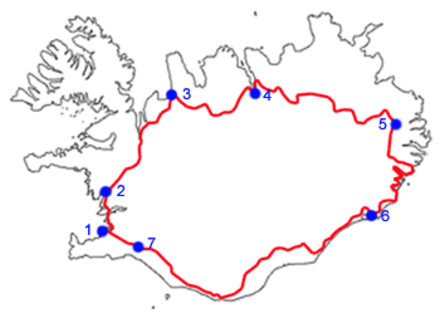
Roads in Iceland can be split into four categories. Roads with one or two digits are main roads, roads with three digits are secondary roads, roads with an "F" prefix are mountain roads and roads with four digits are privately owned roads. This system does not necessarily indicate the quality of the road.
Visitors should know about a handful of key roads for planning and navigation. Road 1 (or the ring road) is clearly the most important as it runs around the country, connecting nearly all regions (except the Westfjords and the interior). Road 1 is for the most part a paved road, with multiple lanes in each direction near the capital area.
- Road 41 runs from the international airport in Keflavik to the capital. It is for the most part a four-lane asphalt road.
- Road 60 and road 61 are the main roads leading to the Westfjords.
- Road 93 runs from Seyðisfjörður, the port of the Smyril line ferry to Egilsstaðir where it meets road 1.
Road conditions

Icelandic roads have varying quality. Main roads (one or two-digit roads) tend to be paved and are generally well maintained. Secondary roads (three-digit roads) are maintained less often and lastly mountain roads (prefixed with "F") are typically for four-wheel drive vehicles and are always closed during winter.
Road numbers starting with an F are for 4x4 vehicles only, and are usually simple dirt paths made by a road scraper, and it's not uncommon that fording rivers is required. Many F-roads are closed from October to mid-June due to extremely bad road conditions. Non-4x4 vehicles are prohibited on these roads.
Because of Iceland's numerous mountains and relatively high humidity, visibility can quickly change from very good to foggy and road conditions from dry to wet rather quickly when ascending in elevation. Many roads (even parts of the main country road) are unpaved and can turn into slippery mud during the summer. Check out Vegagerdin for up-to-date road-condition information.
Skidding
Skidding can happen on gravel roads, winter roads and F-roads. Skidding is tire slipping with the road and it negatively affects the handling of the vehicle.
- Disenganging the clutch is a good way to stop a skid. Rear wheel skids are corrected both by disengaging the clutch and steering in the same direction as the rear is going. Once the car evens itself out, you can smoothly change the direction to where you want it to go.
- Never brake during a skid. The car will slow down with an disengaged clutch. Braking will only make the skid worse.
- It is very easy to panic and overcompensate, abruptly turning the wheels further when the vehicle initially fails to respond. This will quickly put you off the road, into a ditch or in the way of oncoming vehicles.
- After the skid has been corrected lower your speed. Skids happen because you were cornering at high speeds.
Gravel roads
Drivers are required to reduce their speed when on gravel roads, an 90km/h road for example has an 80km/h speed limit once it is on gravel. If the road is transforming into a gravel road slow down prior to the change. Should you meet a car in the opposite direction stay far enough right in order to allow the cars to pass. Turn right early in order to avoid rocks flying into the windshield of the opposing car.
Winter
See also: Winter driving
Driving a car in winter conditions may be challenging. The golden rule for driving on snow, ice and slush is don't rush. Authorities routinely issue road information on the internet and on information signs along the road. Always obtain specific information about mountain passes the day before going. Ask locals or call 1777 (+354 1777) for last-minute information.
In the winter, roads to the Interior are closed due to wet, muddy and snowy conditions. Winter tyres are mandatory in the winter. Some mountain passes can be closed for shorter times and some minor roads may be ploughed only several days after snowfall. When the mountain roads are opened for traffic many of them can only be negotiated by four wheel drive vehicles. The roads requiring four wheel drive (and possibly snow tires) are route numbers with an "F" prefix, e.g. F128. Have adequate equipment to cope with being stuck in snow.
F-roads
See also: Offroad driving
Use the same rules as with gravel roads and expand on top of those. F-roads are either gravel roads or trails. Some F-roads are not bridged and require fording.
Fording
.jpg/440px-Wading_by_car_on_Iceland_(2).jpg) Unless you have been taught how to use a ford or the water is only a few centimetres deep, you should consider an alternative route - as soon as the water starts lapping the vehicle's bodywork, you will start to loose traction and splashing water might affect the vehicle's electrics.
Unless you have been taught how to use a ford or the water is only a few centimetres deep, you should consider an alternative route - as soon as the water starts lapping the vehicle's bodywork, you will start to loose traction and splashing water might affect the vehicle's electrics.
Before you cross an river by car, wade on foot over the river to ensure that it is safe to drive. Use knee high boots and a walking stick. For safety you can tie yourself to the front of the car. Rivers either have an gravel or rocky riverbed. Look for an smooth area over which to cross. Look away from the current every couple of seconds in order to prevent dizzyness. If you encounter a lot of current, keep your knees bent. Should you fall, keep the staff firmly in the riverbead, it will eventually allow you to regain control.
Once you are satified that it is safe to drive, drive slowly using the lowest practical gear. After you have crossed the ford, test your brakes.
Tunnels
There are several tunnels in Iceland. The longest is 9.1 km, typically they are less than half of that. Road 61, road 76 and road 1 have two tunnels each. Tunnels are generally safe and speeds are sometimes lower than in the open. Tunnels are generally very safe places to drive. The main challenge is adapting to the darker tunnel during bright sunshine.
In case of fire or smoke in a tunnel, use the fire extinguisher inside the tunnel, which will alert traffic control and the fire brigade, or use the emergency phones inside the tunnel, which will inform traffic control exactly where you are.
One-lane bridges
Iceland has many one-way bridges. At one-way bridges the first car that arrives at the bridge has right of way. As such, cars should cross the bridge in the same order as they arrived at the bridge. It is also a good idea to use the car's indicator lights to show whether you intend to cross the bridge soon or are waiting for a car on the opposite side to cross. Some longer bridges include passing points.
One of Iceland's one-way bridges has lay-bys on the bridge itself. It is the bridge over Súla, 420m long, with two lay-bys.
Vehicle and gear
On the mountain roads (those with number prefixed with F) four-wheel-drive cars are needed. In winter, Icelandic cars use Nordic quality winter tires (studded tyres are permitted from November to April). Satellite navigation (GPS) can be useful in cities and around Reykjavik, but navigation by road number is more reliable.
For the Interior, a sturdy four-wheel-drive car is necessary. Tell the car rental company that you are going there. Some rivers are crossed by fording with the car.
Summer tyres must have a minimum of 1.6mm-deep groves, while winter tires require a minimum of 3mm-deep groves.
By motorhome
Several companies rent motorhomes, that are "fully equipped" (beds, small kitchen, fridge, shower, toilet, heating, etc.) and as a rough indication they cost about what one might spend on a reasonable rental car and reasonable accommodation – but they allow a lot more flexibility.
Many campgrounds cater to motorhomes (and caravans or camping with tents) and those are well signposted. All have basic facilities (electricity, toilets, hot showers).
Costs
Renting a car is expensive, so visitors should consider for how many days and what part of the trip a car is needed. There is only need for a four-wheel drive in the interior, which is only open in the summer. Expect to pay at least kr 4000 for a compact car and upwards of kr 12,000 per day for a four-wheel-drive vehicle. These prices include basic car insurance, but additional insurance may be purchased to protect against damage from gravel or other common mishaps. Read the fine-print however, because the things that usually break (windshield, tires, bottom of the car) are usually excluded. Supplemental insurance does not cover the underside of the car – you are responsible for damage caused by driving over boulders, potholes or speed bumps, and you will find many of all three on your route. Unresolved complaints can be brought up to the Icelandic ECC if the car rental company is a member of the Icelandic Tourism Federation.
Travellers can see the majority of Iceland's sights with a two-wheel drive vehicle, but those interested in venturing into the interior, for example to Landmannalaugar, will need four-wheel drive – and long experience at the wheel – as roads are rough and rivers may need to be crossed. In some locations it is best not to travel alone due to the difficult terrain and weather conditions. Be aware that renting a four-wheel drive vehicle may require reservations made several months in advance as these vehicles are in high demand. In addition, renting cars on-location is almost never cheaper than doing so in advance. Car rental offices, including those at the airport, are not open around the clock. Off-road driving is strictly forbidden in Iceland and punishable with fines in the range of kr 300,000-500,000. Icelandic nature is sensitive and does not recover easily from tire tracks.
Day rates for the vehicle itself are usually the main expense; the price of fuel is a less important issue. Compact cars with modest engines are the most fuel-efficient. Some car rental agencies have arrangements with petrol stations for discounts for their customers, e.g., customers of Sixt get kr 5 off per litre at Orkan stations, and Europcar has an arrangement with N1. Be sure to ask.
Fuel can generally be obtained 24 hours a day at self-service stations using a charge or credit card, but you will need a personal identification number for that card. Alternatively, most stations sell prepaid cards that can be used to buy gas after-hours. If traveling around the country, the gas tank should be kept near full because stations can be 100–200 km (60 to 125 mi) apart. Petrol costs (as of March 2017) kr 190–200 per litre.
The only toll road in Iceland is the tunnel through Vaðlaheiði, east of Akureyri. Tolls, at kr. 1500, are moderate for a normal car as of October 2020. In 2019 Hvalfjörður Tunnel was given to the Icelandic government (as the toll fees had repaid the cost to construct the tunnel) and thus it is free to drive through it.
Most common damages not covered by insurance

Most, if not all, car rental insurances do not cover the following damages:
- Damage to tires.
- Water damage due to river crossing.
- Damage to doors if they blow out in a strong wind.
- Damage caused by driving on rough road to the vehicle's transmission, engine, drive or other parts that are in or attached to the chassis.
Rules and regulations
Rules and road signs are generally the same as in the rest of Europe with the field of the sign in yellow rather than white so as to contrast with snow. Like the UK, the E-roads are not signposted. Virtually all signs use standardised symbols (pictograms); explanatory text is used occasionally as a supplement, although road closure signs are in English as well.
Right of way
- Traffic from right has right of way, unless signs or lights state otherwise. You must yield to traffic from any road to your right, except from separate areas such as parking lots and petrol stations.
Traffic on roads with the standard "Yellow Diamond" sign has the right of way. This is widely used for main roads.
Universal give way (yield) sign
Buses have right of way when leaving a bus stop
In one-way tunnels and bridges, the first car to arrive has the right of way.
Pedestrians have the right of way at all marked crossings with no traffic lights.
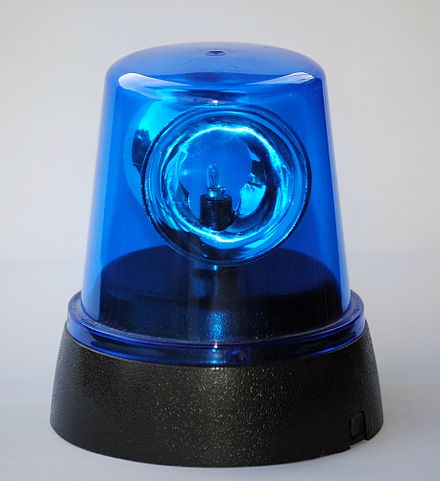 Emergency service vehicles with flashing lights have absolute right of way.
Emergency service vehicles with flashing lights have absolute right of way.Right turn on red is always illegal, even if the road is clear.
Cars on the inner lane on a roundabout have right of way over cars on the outer lane.
Use of equipment
- Headlights are mandatory even during daylight.
- Using a mobile phone when driving is forbidden, unless you are using hands-free equipment
- Wearing a seat belt is mandatory
- Winter tyres must have a minimum depth of tread of 3mm. Summer tyres must have a minimum depth of tread of 1.8 mm
Speed limits
The general speed limit is
- 90 km/h in the countryside
- 80 km/h on gravel roads
- 50 km/h in urban areas
- 30 km/h in residential streets
There are some exceptions from the general limits, which are specifically signed as such (the limit is never higher than 90 though), but be aware that the general speed limit is usually not indicated by signs. Speed cameras are posted around the country, and fines are in the range of kr 5,000–70,000.
There are no specific rules for change of speed limit when driving conditions change. It is your responsibility to adjust your speed when needed. Challenging parts of a road may be marked with blue speed limit signs. Those signs are advisory, but as one who doesn't know the road you should follow them for your own safety.
Vehicles pulling trailers and vehicles must not drive faster than 80 km/h.
Vehicles pulling trailers which are both over 750 kg and without brakes must not drive faster than 60 km/h.
Accidents
- Every person is by law obliged to help and assist at site of accident, even if not involved or guilty.
- Call the police (emergency number 112) if persons are injured or killed. Police should also be contacted if animals are injured or killed.
- If no persons or animals are harmed, police should not be called, but drivers involved should resolve the situation themselves by sharing contact and insurance information.
Other
- Don't drink and drive. The blood alcohol limit is 0.05%, with a minimum fine of kr 100,000. Penalties can include time in prison. Unlike in many countries, this means you cannot have a small beer or glass of wine and then drive.
- On typical Icelandic two-lane road with a narrow shoulder, overtaking is only allowed on long straightaways with plenty of visibility.
- Off-roading is strictly forbidden, unless the ground is covered in deep snow, deep enough not to harm the underlying surface. Violators risk a huge fine.
Where a road is not wide enough for two cars to meet, blue signs with a large M indicate passing points or laybies.
- Do not stop on a highway: find a pull-out (sometimes marked with a blue sign with a white 'M'), a designated parking area (blue sign with a white 'P'), a picnic area, or a farmer's road. Stopping on a road with a 90-km/h speed limit is dangerous and illegal, yet you are bound to see tourists doing this.
- Right turn on red is illegal.
- Using one's vehicle horn is considered impolite and should be used only in an emergency.
- Many petrol stations in rural areas have car-washing bays where you can wash the dirt off your rental car for free using a hose and broom.
Signs and marking

While road markings are informative, they can be covered by snow in winter. In Iceland white lines separate traffic, either in the same direction or opposing traffic. Yellow lines are along the shoulder of the road, along with reflective sticks. In really bad weather with poor visibility, it is a good idea to drive alongside the reflective sticks.
Glossary
See also: Icelandic phrasebook
;bensín : petrol ;bíða eftir snjóplóg : wait for snowplow ;blindhæð : blind rise ;dísel : diesel ;einbreið brú : one lane bridge ;götuhlaup : street run ;hægri : right ;inn : in ;lokað : closed ;olía : oil ;malbik endar : tarmac ends ;negld dekk : studded tires ;slysasvæði : accident area ;stans, veggjald : stop, toll fee ;út : out ;vegur : road ;vetrardekk : winter tyres ;vinstri : left
Stay safe
Driving standards are moderately well-maintained in Iceland, with the traffic being (statistically) among the safest in the world. Fatality rates were dropping prior to 2014, but have been increasing in line with more traffic. Because of Iceland's ever-changing weather, one should keep extra food and know where guesthouses/hotels are located in case of a road closure.
Crossing rivers can be very dangerous, particularly if it has been raining, and should be done with great caution. Driving on gravel can be a challenge, and loss of control on cliff-side roads can easily be fatal.
Animals
Roads through farmlands are fenced, but wild animals do cross roads. Cattle and horses typically cross roads where cattle and horse paths cross the roads and those are marked with warning signs. Reindeer can be seen crossing the road in East Iceland. Note the warning signs.
